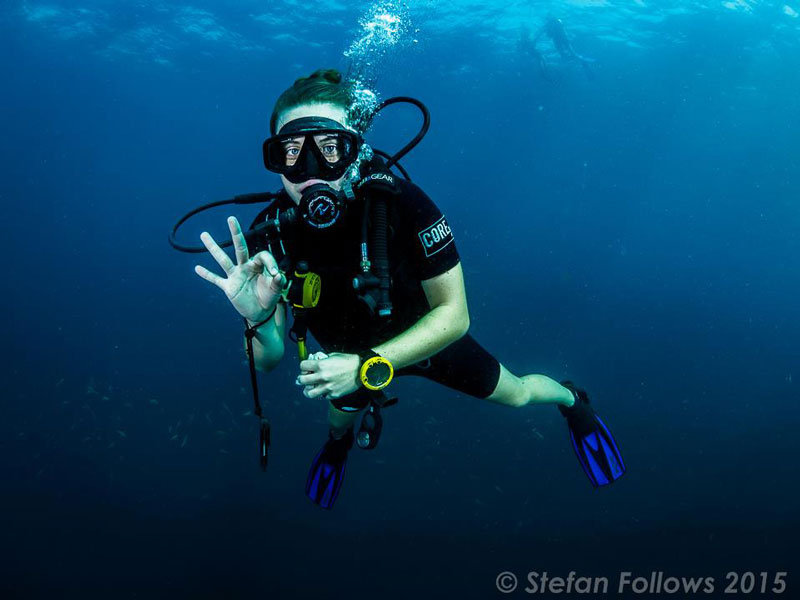It was an early 7 AM start as we head out to Samran Pinnacle. After the necessary coffee infusion, we packed our gear, tanks, knives, scissors and clippers and then caught our boat at the pier. Once underway, our first feat would be actually finding the dive location.
Samran pinnacle sits between Ko Phan Ngan and Koh Tao, about a two hour boat ride for us. Starting at 12-15 meters below, on the surface there are no buoys, lights, road signs or cellphone towers to mark it. The elusiveness is part of what brings us here today. Because it is unmarked, the pinnacle is an easy target for nets to get ensnared during bottom trawls. A captain trawling at night and not paying proper attention can easily miss this pinnacle on his radar or maps and accidentally drive right over it. Not a problem for the boat, but the net will get entangled and often lost as it grips the coral and rock below. This is a huge bummer for everything trying to live on Samran, and for the fisherman who is now out big baht on net.
A Global Problem
These nets are a classic example of what is termed ghost nets, or any lost, abandoned and otherwise discarded fishing gear. Left behind, this gear “continues to fish” as well as damage habitat.
Ghost nets are scary.
First of all, there are a ton of them. Well, actually there are an estimated 640,000 tones of these nets. A UN report in 2009 estimates that ghost nets make up 10% of all marine debris. These nets can have a long term impact. As we have invented nondegradable and highly durable fishing gear, this gear can continue to “fish” for centuries. This net can smother coral and harm fragile life forms, entangle fish and marine mammals, and be detrimental to an ecosystem as a whole. This negative impact can also feedback and harm commercial fish populations.
Stefan briefed us on the potential risks and proper safety for this dive and we geared up. All 8 of us stood at the back of the boat in silence, and waited for the captain to give us the signal that we were over the correct spot. After Stefan found the pinnacle and sent up his SSMB, or more properly, the big orange floaty thing, we jumped off and descend into the underwater world. The pinnacle was alive with pelagic fish, coral dwellers, butterfly fish, wrasse, and barracuda. As it came into clearer view I could see the dark green net hanging motionless over its entire length. We scale down slowly to 30 meters and looked up at the pinnacle and the odd green table cloth that fell around its sides.
Their was lots of work to do.
Dawning our weapons of good intent, we began to cut and disentangle the net as we rolled it down from the top. The work was immediately gratifying as each cut breathed life back into the strangled ecosystem.
After two dives, there was still more to removed. We made a plan to come back on another trip and continue. Although I’m excited to go back , I know that removing the net is only an intermediate fix. What we really need is to develop a way for it not not be there in the first place: on this one tiny pinnacle, in the Gulf of Thailand, and globally.
Solutions
Cutting ghost nets is a short term solution. It allows us to raise awareness and mitigate the problem, but it is also both time and energy intensive. To implement long-term solutions, we need to think more broadly and preventatively about the issue. Some potential management practices are described below.
Markers
Tying boyous to the pinnacle and placing markers on the surface would give a visual landmark for fishers to steer around. However it is likely that these boyous would be torn out from boat traffic.
Documentation
Knowledge is the most important tool for successful management. Collaborating with local fisherman to get an accurate report on nets lost would allow us to understand the severity of the problem. With this information we would have more tools to advocate for a solution.
Technology
Biodegradable fishing nets are a new technology that could put an end to ghost nets. These nets deteriorate when left underwater over an extended period of time and have been shown as effective as nylon nets. The cost of implementing these nets is a major deterrent to their widespread use.
What creative ways can you think of to stop ghost net accumulation?
Send us a mail
Sources:
Images: Stefan Follows
http://www.fao.org/news/story/en/item/19353/icode/
http://www.ghostfishing.org/the-problem/
http://en.wikipedia.org/wiki/Ghost_net

MARINE RESEARCH

MARINE CONSERVATION

GET INVOLVED

Rebecca Lehmann
Author
Rebecca something something colorado. Smallest ears on the planet. Great gal though, for real
%
Percentage of People offended
People giving a rat's arse
- Change created 1%
- Coffee drunk 99%
- Synonyms mangled 66%
- Bar counters overused 100%
No Results Found
The page you requested could not be found. Try refining your search, or use the navigation above to locate the post.



